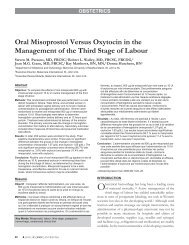The DSM Diagnostic Criteria for Sexual Aversion Disorder - UBC ...
The DSM Diagnostic Criteria for Sexual Aversion Disorder - UBC ...
The DSM Diagnostic Criteria for Sexual Aversion Disorder - UBC ...
You also want an ePaper? Increase the reach of your titles
YUMPU automatically turns print PDFs into web optimized ePapers that Google loves.
Arch Sex Behav<br />
etiology of SAD. <strong>The</strong>re are no empirical data supporting the<br />
speculation that SAD is due to a partner <strong>for</strong>cing sex upon an<br />
individual, despitewhatisclaimed insomepop culturesources<br />
(www.marriagebuilders.com). Avoidance behavior then rein<strong>for</strong>ces<br />
the conditioned avoidance. Because systematic desensitization<br />
has been found effective in two published case studies<br />
of women with SAD (Finch, 2001; Kingsberg & Janata,<br />
2003), SAD was speculated to be similar to other anxiety<br />
disorders which respond quite well to systematic desensitization<br />
(Choy, Fyer, & Lipsitz, 2007). For women, it has been<br />
noted that, in general, SAD is less responsive to behavioral<br />
treatment than is HSDD (Schover & LoPiccolo, 1982); however,<br />
there are no published studies comparing behavior therapy<br />
in HSDD versus SAD. <strong>The</strong>re have been no published<br />
longitudinal studies exploring the etiology of SAD so statements<br />
about proposed mechanisms are based on assertion<br />
only. Moreover, there are no published efficacy studies or case<br />
reports on treatment of SAD in men.<br />
Kaplan (1987) also believed that Mowrer’s (1947) two-factor<br />
theory explained the etiology of sexual aversion but added<br />
that rein<strong>for</strong>cement processes were responsible <strong>for</strong> its maintenance.<br />
Specifically, Kaplan argued that the sexual aversion was<br />
maintained because of a vicious cycle of avoidance and rein<strong>for</strong>cementoftheavoidancebehavior.Becauseavoidanceallows<br />
the individual to be free of the significant sexual anxiety and<br />
distress, avoidance becomes self-perpetuating and there<strong>for</strong>e<br />
rein<strong>for</strong>cing.<br />
Kaplan (1987) noted that psychoanalytic theories also attempt<br />
to explain the etiology of SAD in that the phobic anxiety<br />
is activated among those individuals with unresolved oedipal<br />
conflicts. For those 4–5 year old boys who do not mature from<br />
the stage of having sexual feelings <strong>for</strong> their mothers and being<br />
fearful of castration by their fathers, neurotic anxiety (and sexual<br />
aversion) may develop. Treatment is there<strong>for</strong>e aimed at<br />
resolving the oedipal complex. Un<strong>for</strong>tunately, this particular<br />
theory has never been tested directly nor have there been<br />
empirical tests of the efficacy of psychoanalysis <strong>for</strong> SAD.<br />
Is <strong>Sexual</strong> <strong>Aversion</strong> <strong>Disorder</strong> a <strong>Sexual</strong> Desire <strong>Disorder</strong><br />
AlthoughSADislistedasoneofthetwo<strong>Sexual</strong>Desire<strong>Disorder</strong>s,<br />
thereappeartobefewsimilaritiesbetweenHSDDandSAD—the<br />
<strong>for</strong>mer being characterized by the absence of desire and the latter<br />
as the presence of fear and avoidance. Although Schover and<br />
LoPiccolo (1982) conceptualized SAD and HSDD as being at<br />
opposite ends of the same spectrum, Kaplan (1987) disagreed<br />
with this conceptualization, noting that individuals with SAD can<br />
continue to experience normal sexual desire, fantasize, and often<br />
masturbate to orgasm. Indeed, internet advice columns (e.g.,<br />
psychcentral.com/ask-the-therapist) present queries from individuals<br />
with SAD symptoms despite apparent normal levels of<br />
sexual desire:<br />
I’ma24 yearoldfemale,andIbelieveIsufferfromsexual<br />
aversion disorder. I find the thought of all genital contact<br />
quite repulsive, and on occasions in the past when guys<br />
have tried to touch me belowthewaistIhave become very<br />
panicky and upset. It’s not that I have no sexual desire, I<br />
do, and I masturbate to orgasm around once a week.<br />
In a sample of 376 patients who avoided sex, Kaplan (1987)<br />
found that 21% also met criteria <strong>for</strong> Inhibited <strong>Sexual</strong> Desire<br />
<strong>Disorder</strong> (now classified as HSDD). In an empirical test of the<br />
association between SAD and HSDD, although sexual desire<br />
and sexual aversion scores were significantly correlated (r =<br />
.33, p \ .001), sexual aversion scores accounted <strong>for</strong> only 11%<br />
of the variance in sexual desire scores (Katz & Jardine, 1999).<br />
Research on the distinction between desire and aversion is extremely<br />
limited to outdated studies with poor methodological<br />
design. However, among those seeking treatment <strong>for</strong> sexual<br />
concerns, anxiety was significantly higher among those with<br />
sexualaversioncomparedtothosewithlowsexualdesire(Murphy<br />
& Sullivan, 1981). <strong>The</strong>re was no in<strong>for</strong>mation in the <strong>DSM</strong>-IV<br />
Sourcebook (Schiavi, 1996) justifying SAD as a <strong>Sexual</strong> Desire<br />
<strong>Disorder</strong>.<br />
Overlap Between <strong>Sexual</strong> <strong>Aversion</strong> <strong>Disorder</strong><br />
and Vaginismus<br />
As reviewed by Binik (2009), there is some overlap between<br />
SAD and vaginismus, the latter of which is defined in <strong>DSM</strong>-IV<br />
by a recurrent or persistent involuntary vaginal muscle spasm.<br />
<strong>The</strong> International Consultation Committee sponsored by the<br />
American Urological Association Foundation refined the definition<br />
of vaginismus in recognition of the finding that vaginal<br />
muscle spasm was not universally present among women with<br />
vaginismus whereas fear of penetration was. This group described<br />
vaginismusas ‘‘<strong>The</strong> persistentorrecurrentdifficulties of<br />
the woman to allow vaginal entry of a penis, a finger, and/or any<br />
object, despite the woman’s expressed wish to do so. <strong>The</strong>re is<br />
often (phobic) avoidance and anticipation/fear of pain’’ (Basson<br />
et al., 2003). Basson et al. highlighted the phobic qualities of<br />
vaginismus and concluded that it was fear of penetration that<br />
characterized vaginismus more than vaginal spasm. Because<br />
women with vaginismus are fearful of (painful) vaginal penetration,<br />
this often results in avoidance behavior and even in<br />
aversion in severe cases. It is possible, there<strong>for</strong>e, that some cases<br />
of aversion are due to vaginismus, although both disorders can be<br />
diagnosed simultaneously. Although there are no empirical data<br />
that have sought to differentiate these two disorders, vaginismus<br />
is classified as a sexual pain disorder because of the overlap with<br />
dyspareunia.Iftheaversionisexclusivelyduetofearofpain,then<br />
the diagnosis indeed would be one of vaginismus and not SAD.<br />
Thus, there appears to be enough of a difference in the diagnostic<br />
descriptions of the two disorders to justify their assignment to<br />
different classes of sexual dysfunction.<br />
123
















